
How to Take Care of a Puppy it’s essential to make your home safe for both your furry friend and your belongings. Puppy-proofing is similar to child-proofing, but there are some key differences. Start by imagining your home from your puppy’s perspective. Keep electrical cords, harmful substances, and fragile items completely out of reach. Puppies can jump, climb, chew, and scratch, so place valuable or dangerous items high up or inside locked cabinets. Standard child-proof latches often won’t hold up to a curious puppy, so opt for secure locks or sturdy metal hardware for lower cabinets and drawers—these should be chew-resistant and require dexterity to open.
Once your home is safe, one of the most exciting tasks is choosing your puppy’s name. This will be a word you’ll say countless times, so choose carefully. Pick a name that’s pleasant to say, short enough to be memorable, and easy for your puppy to recognize. Avoid names that sound similar to commands or other words you plan to teach your dog.
Puppy training tips Young pups will inevitably test boundaries, and you might find yourself saying “no!” from time to time. Instead of dwelling on unwanted behaviors, it’s more effective to focus on encouraging positive actions, especially in the early stages of training. While saying “no” may feel necessary, it doesn’t communicate a clear behavior to your puppy. Dogs learn best when we guide them toward what we want them to do rather than just pointing out what not to do. This approach also helps prevent the development of bad habits. So, how can you move away from using “no” and replace it with more constructive training methods? We’ve covered this topic in depth in one of our podcast episodes, which you can listen to, watch, or read a summary of here. Remember, you’re never alone in your puppy training journey. Our community, led by industry professionals, gives dog parents access to a wealth of resources to help raise happy, healthy pups. We’ve teamed up with YouTube’s top dog trainer, Zak George, to bring you extra training tips in our 30 Day Perfect Pup program. Additionally, Pupford Academy offers a comprehensive online library of dog training courses, covering everything from crate training and separation anxiety to impulse control and barking management — and much more. With the Pupford app, these expert resources are always at your fingertips, whenever you need them.
How to train a dog at home If your pup loves playing fetch, dedicate some time for a few rounds of throwing and retrieving. This is a simple way to tire them out while engaging their major muscle groups. You can use toys, balls, or even a stick to make the game more exciting. Begin with short, gentle sessions and gradually increase the intensity as your dog builds strength and stamina. A Rugby Bell Toy from Pawsindia can make fetch sessions even more enjoyable. Another fun option for keeping your dog active is the Wicked Ball. This self-moving motorized ball encourages dogs to chase and follow it, providing excellent cardio exercise while helping with weight management. While exercise is crucial, diet also plays a significant role in your dog’s health and weight loss journey. Managing portion sizes of their regular kibble is just the beginning. Be mindful of the treats you give—these should make up no more than 10% of your dog’s daily intake. Opt for protein-rich, low-calorie treats to see noticeable results. Healthy options like Licks Peanut Butter allow your dog to enjoy a creamy treat while doubling as a way to hide medications or mix into their kibble for picky eaters. Similarly, Raw Bites from Pawsindia Organics make excellent diet-friendly snacks. These dehydrated meat jerkies are low in calories and fat but high in protein, made from premium exotic meats—perfect for keeping your pup satisfied and healthy during dieting.
Best dog food for puppies can also be made at home, offering certain advantages over store-bought options. Preparing your dog’s meals yourself allows you to select the freshest, highest-quality ingredients available. Homemade meals are especially helpful for dogs with food sensitivities or allergies, as you can easily avoid ingredients that cause reactions. For picky eaters or dogs with medical conditions that reduce appetite, a homemade diet is often more enticing than dry kibble or even wet food. If your dog has specific health concerns, certain veterinary-formulated diets may need adjustment, so consult your veterinarian about your dog’s nutritional needs and consider working with a certified veterinary nutritionist. Together, you can create a homemade diet that fulfills your puppy’s dietary requirements. Regardless of health status, always inform your vet if your dog consumes homemade meals, as regular check-ups are essential to monitor nutrition and overall health.
Best dog food for sensitive stomach is often fresh-cooked, human-grade meals, which tend to be more expensive but extremely nutritious. The market for fresh dog food is expanding rapidly, with many subscription options that deliver high-quality meals straight to your door. Some owners prefer to prepare these meals at home, but this should only be done under the guidance of a veterinarian. Fresh-cooked recipes are gently prepared in small batches, preserving their flavor and nutrient content. Many of these meals use limited ingredients and are highly palatable. Human-grade components mean that every ingredient is safe for human consumption. Certain ingredients in dog food can sometimes cause digestive issues. High-fat or high-fiber foods may be responsible in some cases, while in others, the protein source or ingredient quality could be the problem. Some dogs may struggle to digest red meat, while others may react poorly to chicken. Carbohydrates like corn and plant fibers can also be harder for some dogs to process. Identifying the specific cause can be tricky since every dog is unique. Food sensitivities and allergies can be difficult to pinpoint, often requiring veterinary tests and careful trial and error to determine which ingredients cause digestive discomfort.
Dog grooming tips at home Most pet owners choose to bring their dogs to a professional groomer for haircuts. However, with care, you can manage some basic trimming yourself, especially around your dog’s eyes and paws between grooming appointments. Keeping the hair around your dog’s eyes trimmed helps prevent it from obstructing their vision or irritating their eyes. Always ensure your dog is calm, ideally lying down, and work slowly and gently, being extra careful with scissors near the skin. Don’t forget to give your dog a treat afterward to make the experience positive. Trimming the hair inside the ears can promote airflow and reduce the risk of ear infections, but this is typically best handled by a trained groomer or veterinarian. Avoid plucking ear hair at home, as it can cause harm. If you notice excessive hair growth in your dog’s ears, consult your vet for guidance. Always be mindful when using scissors or clippers, as it’s easy to accidentally injure your pet. If you feel unsure or uncomfortable trimming your dog’s hair, it’s safest to rely on professional grooming services.
How to stop a dog from barking starts with understanding why your dog is reacting in the first place. If your dog barks at every movement or stimulus, they may be reactive. Reactivity occurs when a dog responds intensely to ordinary situations, like meeting other dogs or encountering new people. This can show up as persistent barking, growling, lunging, or snapping at whatever triggers them. Dogs exhibiting these behaviours are often called protective or aggressive, but what’s really happening is that your dog is experiencing strong emotions. Barking and similar actions are their natural way of coping and Learning about reactivity and identifying common triggers is essential to addressing your dog’s challenging behaviour. Some dogs manage anxiety well, while others struggle with separation anxiety, which can lead to continuous barking when left alone. Barking may also be accompanied by other behavioural issues, such as chewing, scratching, or excessive licking, which can affect both their health and your home. Focusing on the root cause of the barking, such as separation anxiety, rather than just trying to stop the barking, is key to helping your dog feel secure and happy, even when alone. Every dog is unique, so finding the right approach may involve some trial and error to help your furry friend adjust and reduce barking when left by themselves.
How to potty train a dog begins with creating a consistent routine that both you and your puppy can follow. Using a specific cue word, such as “potty” or “bathroom,” every time you bring your dog to the designated elimination area helps them associate the word with the action. Maintaining a predictable schedule teaches your puppy the behaviors you want them to learn and helps them anticipate what is expected. Puppy pads are an excellent tool for introducing your puppy to potty training while they are still developing bladder control and need to relieve themselves frequently. High-quality pads, like Pet Life Unlimited’s, are absorbent and help neutralize odors, making them ideal for this training stage. During training, pads can serve as a specific spot in your home where your puppy learns to go when nature calls. Placing pads near a back door, for example, can help your dog understand where to go when they need to urinate. If you are unable to get your puppy outside in time, the pads make cleanup simple and protect your flooring. Keep in mind that your puppy may need a few demonstrations before they understand the connection, so patience is essential. If your puppy eats and naps in a playpen or confined area, using pads as flooring not only helps catch accidents but also provides a soft, comfortable surface for them.
Dog care essentials checklist is a must-have for training your dog and creating a safe, cozy space at home. Choose one that allows your dog to stand up and move around comfortably. For wire crates, ensure the spacing between bars is safe so your dog’s paws or head won’t get stuck. If you select a plastic crate, look for one that’s easy to take apart and clean. Dog supplies can add up quickly. Each dog has unique toy preferences, so it may take some experimenting before you find favorites. Keep basic enrichment toys on hand, such as appropriately-sized Kongs, tug toys, or balls, to keep your dog entertained and mentally stimulated. You can also create DIY enrichment activities at home before investing in more expensive items. Before bringing your dog home, make sure they are microchipped and have identification and rabies tags, which your vet or adoption organization can provide. Once you have the tags, register the microchip and take photos of all identification. Email these images to yourself so you can access them quickly if needed.
How to introduce a new pet to your home are going smoothly is the “play bow.” In this posture, a dog lowers her front legs to the ground while keeping her hind end raised. This gesture invites play and often encourages friendly responses from the other dog. Other welcoming behaviors may include sniffing the air toward the other dog, approaching with a relaxed body, or walking with a low, gently wagging tail. It’s important to monitor body language closely and, if needed, redirect the dogs calmly to something else. For instance, both handlers can take a step backward while calling their dogs, have them sit or lie down, and reward them with treats before resuming the walk. Raised hackles—the hair along a dog’s neck standing up—can signal that a dog is feeling uneasy and may need more space and time to adjust. This is a normal, involuntary reaction but should be considered alongside other cues from the dog. Whenever possible, use a loose or slack leash to avoid applying pressure, as tension can alter a dog’s posture and be misread by the other dog. A calm, relaxed approach helps both pets feel comfortable during introductions.



